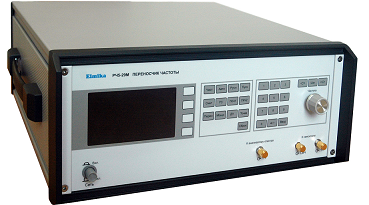Frequency converter

- Automatic frequency measurements
- Millimeter wave to 0,1 - 2,5 GHz frequency converter
- Multi-function capability
- 16.5 - 31 GHz frequency synthesizer
Frequency converter FC5-29M is a measurement instrument which is designed for spectrum conversion of 75 - 170 GHz to 1 MHz ÷ 2,6 GHz range and automatic frequency measurement of sinusoidal signals. When combined with the 1 MHz - 3,0 GHz spectrum analyzer, FC5-29M can be used for examination of the continuous and periodically repeating pulse signals.
The instrument is meant to be used for measurement of various signal sources, radio-transmitting instruments, synthesizers, frequency converters, measurement generators and also for adjustment and verification of various radio-transmitting or communication instruments in laboratory and workshop conditions.
FC5-29M can be controlled remotely through GBIP parallel interface, serial USB2.0 and RS-232 interfaces, as well as through Ethernet interface in remote access mode. The instrument matches the requirements of GOST 22261-82 regarding metrological characteristics
Input signal frequency range from 75 GHz to 170 GHz is being covered by two subranges, which boundary frequencies are defined by mixers' signal input waveguide channels.
| Subrange | Mixer | Waveguide, mm | Frequency range, GHz |
| 2 | SHM-02 | 1,65 x 0,83 (WR - 6) |
110 - 170 |
| 3 | SHM-03 | 2,54 x 1,27 (WR - 10) |
75 - 110 |
Heterodyne (LO) input mixer frequency range from 16,5 to 31,0 GHz.
Mixer output intermediate frequency range from 1,0 MHz to 3 GHz.
Mixer output resistance 50 Ohm.
| Subrange | Mixer | Mixer signal input SWR | Conversion losses, dB | Frequency response irregularity in 2,5 GHz bandwidth, dB | Frequency response input irregularity, dB |
| 2 | SHM-02 | 5 |
6 |
6 |
13 |
| 3 | SHM-03 | 5 |
6 |
6 |
13 |
The instrument provides automatic input sinusoidal frequency measurement at power levels from 1μW to 1 mW.
Reference generator relative error not higher than 5·10-8.
Continuous sinusoidal signal frequency measurement error can be calculated according to the following formula:
ΔFmeas=Fmeas·δFrg±5·N,
where:
Fmeas - measured input signal frequency.
δFrg - reference generator frequency relative error.
N - count unit.
Continuous sinusoidal signal frequency measurement time can be calculated according to the following formula:
Tmeas=1/P+0.2,
where:
P - Frequency meter resolution (Hz).
Embedded frequency synthesizer provides sinusoidal signal in the frequency range of 16,5 to 31,0 GHz and power of no less than 10mW (+10 dBm) at LO output of the instrument.
Minimum frequency changing step at LO output of the instrument is 1 Hz.
Frequency changing period from one frequency to any other within the operation frequency range at LO output of the instrument in not more than 100 μs.
Signal phase noises at the LO output of the instrument are: no more than -60 dBc/Hz at 1 kHz frequency offset from the carrier,
no more than -80 dBc/Hz at 10 kHz frequency offset,
no more than -100 dBc/Hz at 100 kHz frequency offset.
Spectral density of instrument self noise subjected to the input is no more than 3·10 -12 W/kHz in full operation frequency range.
Instrument relative interference level caused by third-order intermodulation distortions is no more than -40 dB when two sinusoidal signals of equal amplitude with the level of 1 μW and the 100 MHz frequency offset between them within the operation frequency range are subjected to the input.
The instrument power supply voltage 220±22 V with 50±1 Hz frequency and harmonics level not higher than 5%.
The instrument provides its technical characteristics after 30 minutes period of warm-up.
It is possible to use the instrument for evaluating measurements after 5 minutes of turning it on, but in this case, the parameters of the instrument are not guaranteed.
The instrument allows continuous operation in working conditions for no less than 20 hours with provision of its technical characteristics.
Note: continuous working time does not include the operation mode setting period.
Instrument power consumption is not higher than 85V·A.
Microwave frequency radiation level produced by the instrument is not higher than 5·10 -5 W/m2 at 1 meter distance from the instrument.
The instrument can be controlled remotely through GBIP parallel interface in accordance with IEEE 488.1 standard (GOST 26.003-80).
Outline dimensions (length, width, height) and mass of the instrument:
| Without packing | Standard packing | Transportation packing | |||
| Outline dimensions, mm | Mass, kg | Outline dimensions, mm |
Mass, kg |
Outline dimensions, mm |
Mass, kg |
| 386x364x156 | 10 | - |
- |
400x400x200 |
12 |
